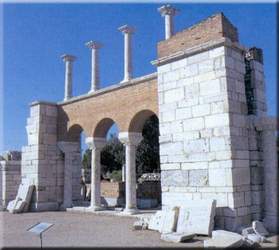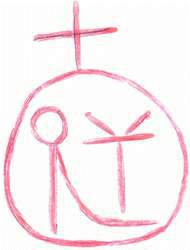

Ephesus church is one of the seven churches , which appears in Holybible. In the first century it was respected widely.Christians call Ephesus "Expected". Later than it lost value.Because of this, it also called "First love that was downfall". It is supposed; Ephesus Church can be at St.John Bazilica's place. So we will explain the St John Church which was on Ayasuluk Hillock.
 |
SAINT
JOHN BAZILICA (Selçuk) |
|
Another tradition holds that he slept here in his tomb waiting for the Second Coming, and
showed signs of life by scattering the dust, called manna, which healed the sick. |
||
 Persecution Gate: Now;museum entrance gate |
The first monument erected on the tomb was probably a small square martyrium. In the fourth century this was replaced by a three-aisled cruciform church with arms radiating from the tomb. Its architecture imitated that of the Church of the Holy Apostles built by Constantine the Great in Constantinople. It is also claimed that the shape of the building was inspired by the tradition that St John dug his own grave in the form of a cross and lay down in it. |
|
 |
Left;
Queen Teodora's monogram. Right; King Justinyen's monogram. |
 |
| It was entered from a courtyard surrounded by a colonnoded portico built partly on the terrace partly obtained by vaulting over the sloping hill. Access to the nave was by a long and narrow narthex topped by five small domes. The plan of the actual building was in the Icon of St John the Theologian from the Monastery of St Barnabas in North Cyprus. Nineteenth century. The inscription in Greek, reads in the beginning was the Word, and the Word was with God, and the Word was God. He was in the beginning with God. All things came to be through him, and without him nothing came to be. What come to be through him was life, and this life was the light of the human race; the light shines in the darkness, and the darkness has not overcome it (in 1:1-5).form of a cross. Its nave consisted of four bays covered with domes which rested on marble columns and brick buttresses faced with marble. The building probably had galleries. |
|
The capitals of the columns bore the monograms of Justinian and Theodora. Under the third dome was the Tomb of St John, reached by a flight of steps; over the tomb was the altar. |
|
|
Most of the
building material came from the ruins of the basilica which stood in the upper agora of
Ephesus (destroyed probably by an earthquake around 500) and from the ruins of the Temple
of Artemis lust below the hill. The floor was covered with geometric mosaics, the walls
and domes had mosaics and frescoes depicting subjects from the Old and New Testaments. On the north side was a large octagonal baptistry with stairs for total immersion, bringing to mind that of the Double Church. The rectangular room next to it was the secrefon' where the bishop presided as judge. An aqueduct was built to supply fresh water from the spring in the eastern heights some ten kilometres away. |
|
These informations was referenced from; 19th. period lecture trip for Turkish National guiding, Fatih Cimok's book (a guide to Seven Churches) and www.turizm.gov.tr - www.kultur.gov.tr sites.
[ Smyrna ] [ Sardis ] [ Thyateira ] [ Philedelphia ] [ Pergamum ] [ Laodicea ] |